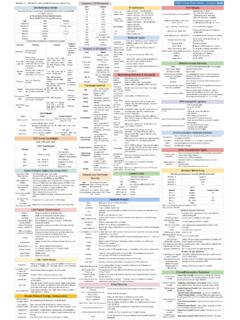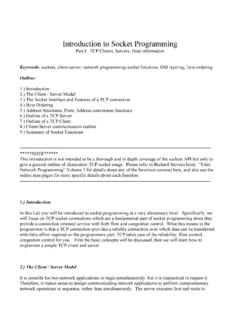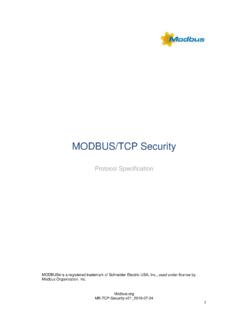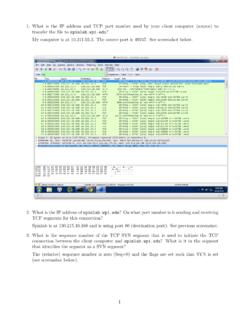Transcription of NetBIOS over TCP/IP, and WINS
1 Guide to TCP/IP: IPv6 and IPv4, 5th Edition, ISBN 978-13059-4695-8 Pyles, Carrell, and Tittel 1 NetBIOS over TCP/IP, and wins NetBIOS over TCP/IP NetBIOS over TCP/IP (NetBT or NBT) was implemented to allow Windows 2000 and Windows XP computers to communicate with devices and share resources on the network running older Windows operating systems. In Windows 7, the default NetBIOS setting is to use the NetBIOS setting provided via DHCP. If a Windows 7 computer uses a static IPv4 address, it will automatically use NetBIOS over TCP/IP. Broadly speaking, NetBIOS works by maintaining a list of unique names assigned to network resources; providing the services to establish, defend, and resolve these names; and carrying the necessary communications between applications that make use of these network resources.
2 Named resources include files, services (processes), users, computers, and Windows workgroups and domains. NetBIOS ensures that names are accurate, current, and unique, and it provides the APIs with access to these resources. An application makes a call to the NetBIOS API to access a named resource or discover the names of available resources. Depending on the precise configuration of NetBIOS on the particular machine, NetBIOS may take a variety of steps to resolve the name to an address. It can then send messages to query the named resource, or it can open and maintain a session. Traditionally, for most Windows clients, NetBIOS was the native method used to access network resources and share their own resources with others. A network with Windows 2000 or clients and servers didn t require NetBIOS .
3 In practice, however, there are still some networks that require NetBIOS to share resources with clients. Drawbacks to NetBIOS NetBIOS has two serious drawbacks. The most serious is that it does not have a network component to its namespace. NetBIOS names are only names, not addresses. This differs from IP addresses, which have a host portion and a network portion. Because NetBIOS names only have a host portion, they are considered nonroutable. (Another way of saying this is that NetBIOS uses a flat namespace.) IP, by contrast, uses a hierarchical namespace, such as NetBIOS requires TCP/IP or some other network-aware protocol to be useful across network boundaries. The second drawback is less serious but seems even more intractable. NetBIOS is a chatty protocol, constantly sending short messages for a wide variety of purposes.
4 This characteristic, which was trivial on the 20- to 40-machine networks of the 1980s, can be a significant weakness on networks with hundreds of clients, particularly when WAN connections are used for name resolution. NBT NBT is defined by RFC 1001, Protocol Standard for a NetBIOS Service on a TCP/UDP Transport: Concepts and Methods, and RFC 1002, Protocol Standard for NetBIOS Service on a TCP/UDP Transport: Detailed Specifications. NBT was implemented to correct the shortcomings of NetBIOS . NBT is typically used on networks that do not have access to a DNS server, are not operating in a domain, and are using older versions of Windows and Microsoft applications and services. Under these circumstances, NBT allows a computer to browse the network and locate other computers and services.
5 It also allows file sharing across the network and provides name resolution services. If the Windows computers on your network require NBT and if the device providing DHCP, such as a DSL modem, does not have a configuration setting that can provide NBT, you may have to manually enable NBT on your Windows computer. This task is performed Guide to TCP/IP: IPv6 and IPv4, 5th Edition, ISBN 978-13059-4695-8 Pyles, Carrell, and Tittel 2 in the Internet Protocol Version 4 (TCP/IPv4) Properties box. On the General tab, click the Advanced button. On the Advanced TCP/IP Settings box, click the wins tab. And then, under NetBIOS setting, select the Enable NetBIOS over TCP/IP radio button. On the vast majority of today s networks, it will be unnecessary to enable NBT, given that DNS use is ubiquitous, even in small office/home office (SOHO) environments.
6 Also, the use of Windows 7 and modern Microsoft applications and services is rapidly rendering NBT unnecessary. NBT is not supported in IPv6, and there is no method of configuring the use of NBT in the properties of an IPv6 protocol for a network adapter. wins Windows Internet Name Service ( wins ) is a service that resolves NetBIOS names to IP addresses in routed networks. This requires the use of a wins server on the network, such as Windows Server 2003. A Windows client computer must be configured to look for the IP address of one or more wins servers on the network. wins is ideally used in networks that require NBT for name resolution, which typically means a network using older versions of Windows or a mix of modern and older Windows computers. The use of a wins server on a network automates dynamic name resolution.
7 For instance, when a DHCP server changes the IP address of a wins -enabled network node, the wins data for the computer is updated on the wins server database. This reduces the need for nodes to issue IPv4 requests for NetBIOS name resolution. How wins Works If a Windows network node requires NetBIOS name resolution, it will first check its local NetBIOS computer name. It then looks at its local NetBIOS name cache for remote names. If the name-to-address mapping isn t found, the node forwards its NetBIOS query to the primary wins server configured in the IPv4 properties of its network adapter. If the primary wins server does not respond, it will query any other wins servers it is configured for, if they exist. Only if no wins server responds will the node send a broadcast NetBIOS query to the local subnet.
8 Finally, if these attempts have been unsuccessful, the node will check its LMHOSTS file and then its HOST file for the mapping. wins servers rely on direct communications (unicasts) between themselves and the clients (end nodes) attempting to register and resolve NetBIOS names. wins clients configured as p-nodes, m-nodes, or h-nodes may attempt to register or resolve NetBIOS names by contacting the wins server(s) configured for their use. When interacting with the wins server, all three node types behave the same way. wins -enabled clients can be configured to use more than one wins server. Older wins clients could only be configured to use one primary and one secondary wins server. Windows 2000 and Windows XP clients can be configured to use 11 secondary wins servers.
9 The client attempts to use the primary wins server first. (This is the first in the list, if you are configuring the client from the Advanced TCP/IP Settings dialog box.) If the primary wins server does not respond, the client uses any secondary wins server(s) configured for it, using them in the order listed in the Advanced TCP/IP Settings dialog box. You should avoid using more than one or two secondary wins servers, because the wins client will query each wins server in its list, attempting name resolution until the list is exhausted. This can cause an unnecessary increase in network traffic. When a node, user, or process with a NetBIOS name signs on to the network or starts up, it attempts to register its name. If it is configured to use wins , it sends a Name Registration Request packet to the wins server.
10 If the name is in the proper form for NetBIOS names and no record for that name already exists in the wins server s database, the wins server Guide to TCP/IP: IPv6 and IPv4, 5th Edition, ISBN 978-13059-4695-8 Pyles, Carrell, and Tittel 3 sends a positive Name Registration Reply packet to the node and enters the name in its database. The wins server s response includes the TTL (six days by default) for the name. The node attempts to renew this name at half the TTL value three days time if it received the default TTL. If a name is not renewed within the TTL, the name is released and made available for use by the next entity attempting to register it. If the name already exists in the database, the wins server sends a Wait Acknowledgment (WACK) to the node attempting to register. This message acknowledges the receipt of the Name Registration Request packet without either granting or denying it, but asks the node to wait.









